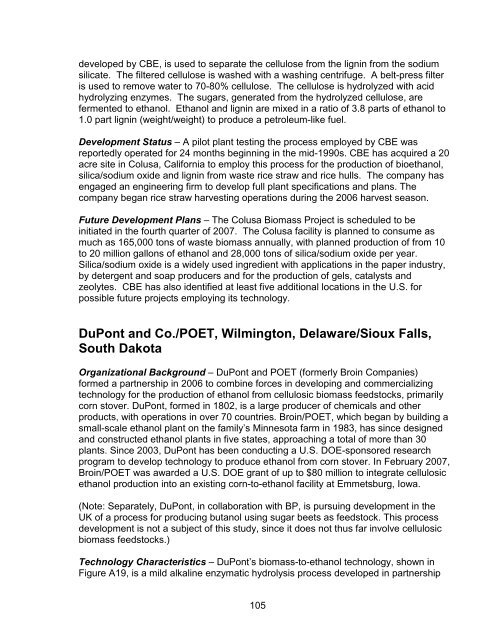Assessment of Conversion Technologies for Bioalcohol Fuel ...
Assessment of Conversion Technologies for Bioalcohol Fuel ...
Assessment of Conversion Technologies for Bioalcohol Fuel ...
Create successful ePaper yourself
Turn your PDF publications into a flip-book with our unique Google optimized e-Paper software.
developed by CBE, is used to separate the cellulose from the lignin from the sodium<br />
silicate. The filtered cellulose is washed with a washing centrifuge. A belt-press filter<br />
is used to remove water to 70-80% cellulose. The cellulose is hydrolyzed with acid<br />
hydrolyzing enzymes. The sugars, generated from the hydrolyzed cellulose, are<br />
fermented to ethanol. Ethanol and lignin are mixed in a ratio <strong>of</strong> 3.8 parts <strong>of</strong> ethanol to<br />
1.0 part lignin (weight/weight) to produce a petroleum-like fuel.<br />
Development Status–A pilot plant testing the process employed by CBE was<br />
reportedly operated <strong>for</strong> 24 months beginning in the mid-1990s. CBE has acquired a 20<br />
acre site in Colusa, Cali<strong>for</strong>nia to employ this process <strong>for</strong> the production <strong>of</strong> bioethanol,<br />
silica/sodium oxide and lignin from waste rice straw and rice hulls. The company has<br />
engaged an engineering firm to develop full plant specifications and plans. The<br />
company began rice straw harvesting operations during the 2006 harvest season.<br />
Future Development Plans–The Colusa Biomass Project is scheduled to be<br />
initiated in the fourth quarter <strong>of</strong> 2007. The Colusa facility is planned to consume as<br />
much as 165,000 tons <strong>of</strong> waste biomass annually, with planned production <strong>of</strong> from 10<br />
to 20 million gallons <strong>of</strong> ethanol and 28,000 tons <strong>of</strong> silica/sodium oxide per year.<br />
Silica/sodium oxide is a widely used ingredient with applications in the paper industry,<br />
by detergent and soap producers and <strong>for</strong> the production <strong>of</strong> gels, catalysts and<br />
zeolytes. CBE has also identified at least five additional locations in the U.S. <strong>for</strong><br />
possible future projects employing its technology.<br />
DuPont and Co./POET, Wilmington, Delaware/Sioux Falls,<br />
South Dakota<br />
Organizational Background–DuPont and POET (<strong>for</strong>merly Broin Companies)<br />
<strong>for</strong>med a partnership in 2006 to combine <strong>for</strong>ces in developing and commercializing<br />
technology <strong>for</strong> the production <strong>of</strong> ethanol from cellulosic biomass feedstocks, primarily<br />
corn stover. DuPont, <strong>for</strong>med in 1802, is a large producer <strong>of</strong> chemicals and other<br />
products, with operations in over 70 countries. Broin/POET, which began by building a<br />
small-scale ethanol plant on the family’s Minnesota farm in 1983, has since designed<br />
and constructed ethanol plants in five states, approaching a total <strong>of</strong> more than 30<br />
plants. Since 2003, DuPont has been conducting a U.S. DOE-sponsored research<br />
program to develop technology to produce ethanol from corn stover. In February 2007,<br />
Broin/POET was awarded a U.S. DOE grant <strong>of</strong> up to $80 million to integrate cellulosic<br />
ethanol production into an existing corn-to-ethanol facility at Emmetsburg, Iowa.<br />
(Note: Separately, DuPont, in collaboration with BP, is pursuing development in the<br />
UK <strong>of</strong> a process <strong>for</strong> producing butanol using sugar beets as feedstock. This process<br />
development is not a subject <strong>of</strong> this study, since it does not thus far involve cellulosic<br />
biomass feedstocks.)<br />
Technology Characteristics–DuPont’s biomass-to-ethanol technology, shown in<br />
Figure A19, is a mild alkaline enzymatic hydrolysis process developed in partnership<br />
105
















